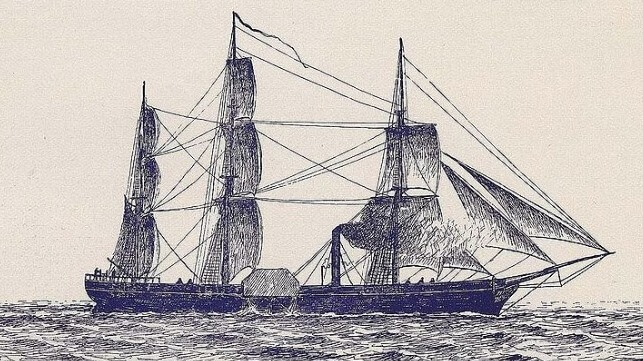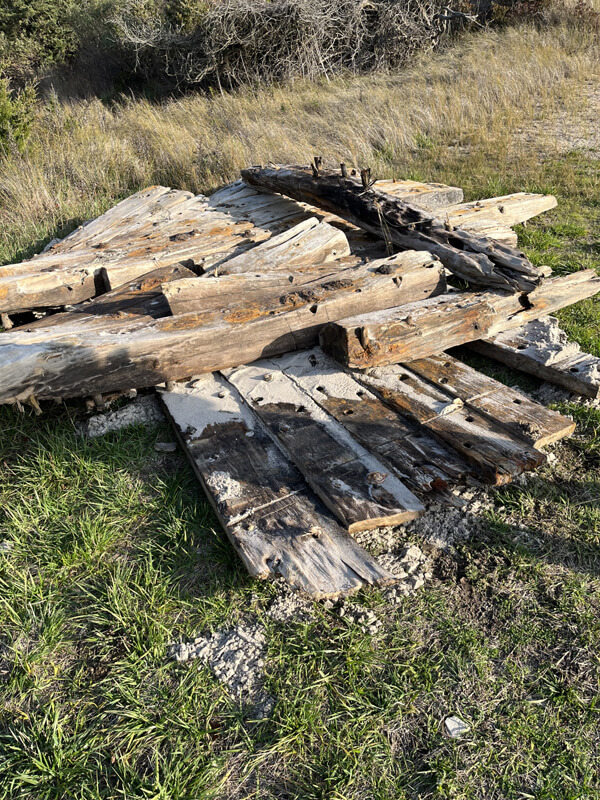Wreck of the Savannah, First Atlantic Steamship, May Have Been Found

The U.S.’s National Park Service and local historians on New York’s Fire Island believe they may found the wreckage from one of the most historic vessels, the first steamship to cross the Atlantic more than 200 years ago. The wreck eluded historians who searched for it 65 years ago, but a topical storm that reached the Fire Island area in October 2022 may have finally revealed a 13 by 13 foot section of the hull of the famous ship Savannah
National Park Service staff had observed the wreckage partially exposed before the storm, but on October 21, Clair Formanski, one of the rangers for the Fire Island National Seashore, notified the curatorial staff that the storm had exposed the remains of a ship. It was located about 2.75 miles east of Old Inlet and was retrieved after subsequent stormy weather moved the exposed wreckage further down the beach.
Researchers quickly identified that it was a smaller vessel likely built around 1820. Studying the trenails, the wooden pegs that were driven into the planks of the ship to secure them, they determined the ship was roughly 100 feet in length. Further, the iron spikes found in the section are consistent with construction from that time frame as well as staining which would be consistent with the “whitening” applied to hulls to protect against shipworms.
“We are consulting with subject matter experts regarding the identification of the wreck,” says the National Park Service. “Of known wrecks, the steamboat Savannah has risen to the top as a contender.”
Because of the number of wrecks known as well as the wrecks not recorded in the area it may not be possible to positively identify the sections, but the Fire Island Lighthouse Preservation Society, which has custody of the wreck, is excited as it is the largest piece of a shipwreck the society has on display. It is a significant piece of history that would be all the more important if the researchers determine it is the Savannah. The society hopes to display the section by this summer just over 200 years after the Savannah grounded and broke apart on Fire Island.

The 13 x 13 foot section found in 2022 on Fire Island - photo courtesy of Tony Femminella, Executive Director, Fire Island Lighthouse Preservation Society
The Savannah was built in 1818 in New York, originally designed as a sailing ship, but Captain Moses Rogers and the Savannah Steam Ship Company ordered the addition of a steam engine and boiler along with sidewheels to the ship. The paddlewheels were 16 feet in diameter and unique as they were retractable by folding them up and placing them on deck when not in use. The Savannah as the ship was named was also outfitted to carry 32 passengers and had three furnished lounges earning her a comparison to a luxury yacht. The Savannah was 98 feet in length consistent with the National Park Services’ estimate the wreck was around 100 feet in length.
The Savannah conducted her first trials in March 1819 using her steam engine for at least 30 minutes. Steam was a novelty with many people referring to the ship as a “steam coffin.” She was viewed as experiential as the first successful application of steam on railroads would not come for another decade after the Savannah.
The ship drew international attention, including U.S. President James Monroe toured and sailed on the ship before its famous Atlantic crossing. When she reached Europe people flocked to see the ship, including ranking naval officers who wanted to see a steam-powered vessel. The Emperor of Russia came aboard the ship in St. Petersburg and the Prince of Sweden and Norway visited her in Stockholm.
The Atlantic crossing began on May 22, 1819 (today commemorated as National Maritime Day in the U.S.). The steam engine was only used when weather and sea conditions permitted or less than 90 hours of 29 and half-day crossing. Still, there were various sightings of the ship under steam, with some reports suggesting she reached 10 knots. Many people seeing the Savannah underway thought she must be on fire with the smoke billowing from her deck. Although the boiler and engine and coal and wood stores took up most of the space on the ship, she still ran out of fuel by the time she reached Ireland, completing the trip to Liverpool under sail. She then made a tour around the Baltic with reports the Swedes were some intrigued by the ship that they offered to buy it.
The Savannah returned to the United States in the fall of 1819 but the weather on the return crossing was too bad for the use of the engine until she neared the United States. As it turned out, it would be her only Atlantic crossing, but she had claimed the tile of the first steamship to cross an ocean nearly 30 years before any other ship.
Financial problems forced the Savannah’s owners to sell the engine in 1820 but the ship continued to operate along the Atlantic coast under sail. On November 5, 1821, caught in the fog, she ran aground on Fire Island. The crew was rescued without injury and the cargo of cotton was salvaged but the ship broke up in a winter storm the following February. Records show that the ship beached near the Old Inlet in the area where the wreckage was found last fall.
The 2023 efforts to confirm that the Savannah has been found are not the first time historians have looked for the famous ship. Maritime historian and reporter Frank Braynard led a volunteer effort in 1958 to find the wreck using divers and even a blimp. While they failed to find the Savannah, Braynard celebrated the ship in a book and was successful in leading an effort to convince then president Dwight Eisenhower to name America’s then under construction nuclear-powered merchant ship Savannah in honor of her famous predecessor. Braynard had hoped to find a piece of the 1819 ship to display on the nuclear ship and never gave up hope of finding the wreckage of the world’s first ocean-going steamship.
